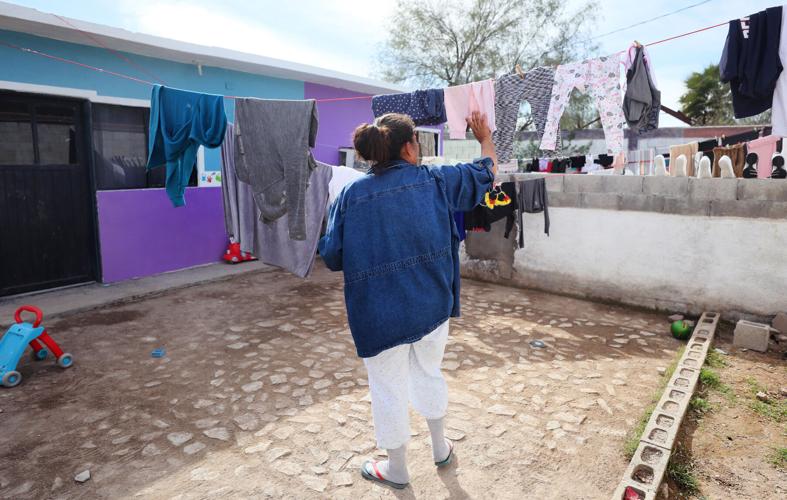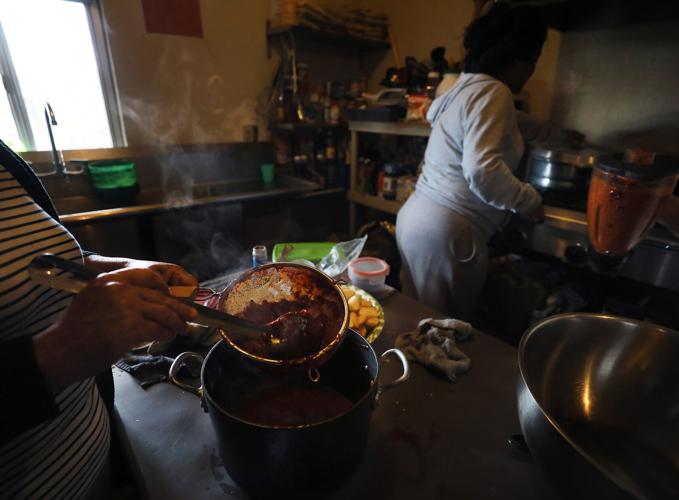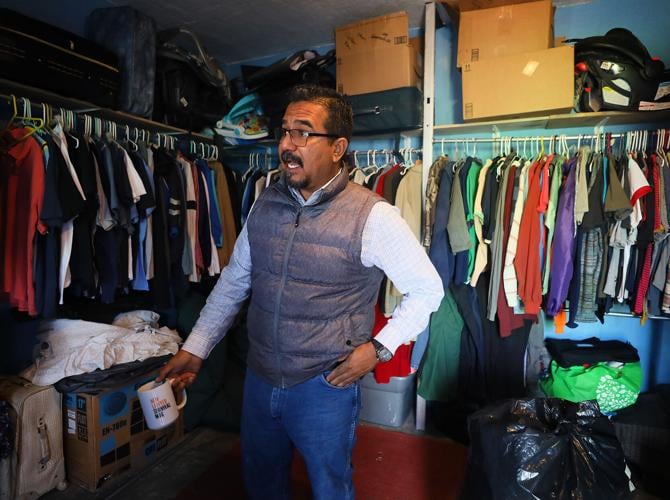SONOYTA, Mexico — Meyling holds in tears as she and her partner, who have been at the border in Sonora for a month, question whether they’re going to get a chance to ask for asylum in the U.S. for themselves and their three young children.
The family is from Nicaragua, one of the countries included in the latest expansion of Title 42, a public health policy that the U.S. has used for nearly three years to expel migrants who enter the country undocumented.
The U.S. has used Title 42 to expel migrants more than 2.5 million times since March 2020 when it was enacted, mostly to Mexico. For most of that time, Mexico would accept only its own citizens as well as migrants from the Northern Triangle: Guatemala, Honduras and El Salvador. Therefore, many migrants from farther away were primarily exempt from the expulsion and would be processed under immigration law and given a day in court where they could ask for asylum.
In October, the U.S. made a deal with Mexico to accept thousands of migrants from Venezuela who have entered the U.S. undocumented while also creating more legal pathways for Venezuelans to enter the U.S. And on Jan. 5, President Joe Biden announced migrants from Nicaragua, Cuba and Haiti would be added to that list.
The U.S. could expel 30,000 people from those countries to Mexico a month, and at the same time 30,000 people a month from those countries would be allowed to come into the U.S., but only if they applied for the program before making the trip to the border.
Nearly 76,000 Haitians, Cubans and Nicaraguans were apprehended by border authorities in November, the most recent data available, a quarter of which were families and children, according to federal data.
In Arizona, people from Cuba, Nicaragua and Haiti account for almost a quarter of migrants apprehended at the U.S.-Mexico border in Arizona in October and November, the first two months of fiscal year 2023.
Confusion about the changes
The announcement on the change last week created immediate confusion among migrants who were already at the border and for many of the shelters and centers in Sonora that serve them.

Migrant women cook a meal in the kitchen at Centro de Esperanza.
Meyling and her family left Nicaragua because of the economic crisis and violence, and they cannot go back, she says.
Meyling and her family spend their days at the Centro de Esperanza migrant resource center and shelter in Sonoyta, a midsize Mexican border town south of Ajo that many Americans drive through on the way to Rocky Point. The Arizona Daily Star is using only Meyling’s first name because the center asks journalists not to use migrants’ last names due to the dangers many face, both at home and at the U.S.-Mexico border.
The center’s courtyard is full of families. Small children play with toys in a sandy area. Teens pass a volleyball in the courtyard and a group of women prepares huge pots of carne de puerco in red sauce, white rice and potatoes.
The center, run by the nonprofit Shelters for Hope, is working on fundraising to expand but currently has limited overnight space for families. They also serve about 150 people a day, providing food, clothing, showers, basic medical care, a safe place for families to be during the day and more.
On Wednesday, Meyling was asking the same question many had — how could she apply for the new program from her home country when she was already at the border?
How the two new programs work
There are two expanded ways that migrants can come into the country.
One is the Alternate Travel Initiative, which includes migrants from Ukraine and Venezuela and just expanded to include migrants from Haiti, Nicaragua and Cuba.
The other program is a Title 42 exemption that’s a more formal process to one that has been quietly happening for a while now.
The Title 42 expansion in October that created legal pathways for more Venezuelans to enter the country while also expelling more under Title 42 seems to be achieving its goal of curbing unauthorized immigration at the border. From the month prior to the month after the new policy, the number of Venezuelans apprehended at the border dropped by 60%.
Migrants who apply for this program need a sponsor in the U.S. to start the process. These sponsors are typically friends or family members.
After passing background checks, eligible migrants would be allowed to live and work temporarily in the U.S. and could apply for asylum.
People are also supposed to apply for the program from their home country or another country besides Mexico. The idea is that they would not have to cross a land border at all but can fly directly to where their sponsor is, which can be anywhere in the U.S.
What that explicitly means is that those who were already in Mexico or at the border when the announcement was made can still apply, but those who crossed into Mexico without authorization after Jan. 5 won’t be eligible.
They are eligible for the second option, however, the Title 42 exemptions, which is open to a limited number of migrants from any country.
People can apply through the CBP One app if they attest that they or their family member qualify for at least one of six reasons, which include having a physical or mental illness, having a disability, being pregnant, not having access to safe housing or shelter in Mexico, being under the age of 21 or over 70, or having been threatened or harmed while in Mexico.
Migrants can apply for this program only if they are anywhere north of the 19th parallel — 19 degrees north of the earth’s equatorial plane — which is roughly a bit south of Mexico City.
They will receive an appointment to be processed at a port of entry. There are eight ports of entry across the Southwest border where migrants can apply for these appointments through the app, one of which is in Arizona.

Migrants can receive medical attention at Centro de Esperanza, a migrant shelter in Sonoyta, Mexico.
Application option
The Dennis DeConcini Port of Entry in Nogales is processing 60 people a day, including holidays and weekends, under this exemption: 30 in the morning and 30 in the afternoon.
The ability to make an appointment from an app rather than waiting at a port of entry will likely make it easier and safer for people, says Bonnie Arellano, supervisory program manager for admissibility with the Tucson Field Office.
“Having a mom with three kids stand outside the port for several hours waiting to come in as compared to getting an appointment and coming in through CBP One are two very different stories for that person,” she said. “This gives them an opportunity to get to the port in a timely fashion, know that they’ll be able to be received at a certain time and get the opportunity to tell their story.”
As it’s been, individuals and families sometimes wait months at the border, in a sort of limbo, hoping to seek asylum in the U.S. while living in often subpar conditions and being vulnerable to exploitation.
Allowing migrants to apply for the Title 42 exemption themselves, rather than needing a third party to do it for them, which is how it worked before this change, is a step in the right direction, says Joanna Williams, executive director of the Kino Border Initiative, a binational organization that provides humanitarian aid to migrants in Nogales, Sonora.
“It’s a step in the right direction in the sense that it allows an individual to submit their case to the government rather than them being dependent on another organization or actor,” she said.
In the past, different organizations or individuals such as a private lawyer could refer cases for a Title 42 exemption to the U.S. government, sometimes giving those who could afford to pay someone an advantage over the most vulnerable migrants.
But there are still access issues with the new process. The application is currently only in English and Spanish, which can limit who applies. The Yuma area has seen people crossing the border from 176 countries, speaking 200 languages.
Another barrier is access to WiFi and a cell phone. Williams says even less expensive cell phones are more likely to have problems navigating the app.

Migrants play around with a volleyball in the courtyard at Centro de Esperanza.
What the programs will look like here
The Kino Border Initiative is helping people who come to them in Nogales, Sonora, navigate the app, which went live Thursday, Williams says. Appointments for the next two weeks opened Thursday morning, and a significant number of migrants were able to get one.
But although Kino provides migrants with information and has trained staff who can help, there are concerns for migrants in more rural areas of the border who are not necessarily getting access to information in a timely fashion, Williams says.
As far as the other program, which expanded Title 42 expulsions, the first 100 people who get expelled from the U.S. each day through the Arizona border are bused to Hermosillo, Sonora, Williams said.
She is “deeply troubled” by the expansion of Title 42 expulsions and is concerned about the conditions people are waiting in while navigating this new reality.
“The Biden administration theoretically was going to end Title 42 because there’s no public health justification for it,” she said. “This instead, using it more and more as an approach to border management, is an unsustainable tool. Congress didn’t pass this law with this intention. And so it’s continuing to use more of a bandage approach that causes real harm to the families that are expelled into limbo in Mexico.”
Yuma is one of the areas of the U.S.-Mexico border in Arizona that has seen a large influx of migrants in the last few years, many of whom were being allowed to come into the country to await a day in court to ask for asylum.

Aaron Flores, co-director, talks about the clothing donated at Centro de Esperanza. The shelter is a former hotel that opened in January 2018. Migrants can pick out clothing for themselves for free.
Amanda Aguirre, president and CEO of the Regional Center for Border Health, which provides same-day services to migrants, says the numbers of people they are helping has been enormous — up to 500 a day.
More of the services the health center and many other migrant service providers in the U.S. are providing are able to be covered by grants, most recently funded with $800 million in the federal omnibus spending bill, passed in December.
But it is hard to say whether the expansion will change the influx of people they see in Yuma, Aguirre says, especially if migrants applying for the new legal pathways still come through the Arizona ports of entry.
“The challenge is still going to be there,” she said.
President Joe Biden said the U.S. would immediately begin turning away Cubans, Haitians and Nicaraguans who cross the border from Mexico illegally, his boldest move yet to confront the arrivals of migrants that have spiraled since he took office two years ago. The new rules expand on an existing effort to stop Venezuelans attempting to enter the U.S.
Photos: Biden visits the border for the first time

President Joe Biden talks with U.S. Border Patrol agents as they walk along a stretch of the U.S.-Mexico border in El Paso Texas, Sunday, Jan. 8, 2023. (AP Photo/Andrew Harnik)

President Joe Biden walks with U.S. Border Patrol agents along a stretch of the U.S.-Mexico border in El Paso Texas, Sunday, Jan. 8, 2023. (AP Photo/Andrew Harnik)

President Joe Biden walks with U.S. Border Patrol agents along a stretch of the U.S.-Mexico border in El Paso Texas, Sunday, Jan. 8, 2023. (AP Photo/Andrew Harnik)

El Paso police officers pat down and arrest two Venezuelan migrants at the camping site outside the Sacred Heart Church in downtown El Paso, Texas, Sunday, Jan. 8, 2023. President Joe Biden arrived in Texas on Sunday for his first trip to the U.S.-Mexico border since taking office, stopping in El Paso after two years of hounding by Republicans who have hammered him as soft on border security while the number of migrants crossing spirals. (AP Photo/Andres Leighton)

El Paso police officers search the belongings of a Venezuelan migrant at the camping site outside the Sacred Heart Church in downtown El Paso, Texas, Sunday, Jan. 8, 2023. President Joe Biden is heading to the U.S.-Mexico border on Sunday, his first trip there as president after two years of hounding by Republicans who have hammered him as soft on border security while the number of migrants crossing spirals. (AP Photo/Andres Leighton)

Venezuelan migrant Jose Castillo looks skywards while praying at the camping site outside the Sacred Heart Church in downtown El Paso, Texas, Sunday, Jan. 8, 2023. President Joe Biden arrived in Texas on Sunday for his first trip to the U.S.-Mexico border since taking office, stopping in El Paso after two years of hounding by Republicans who have hammered him as soft on border security while the number of migrants crossing spirals. (AP Photo/Andres Leighton)

Venezuelan migrants pray at the camping site outside the Sacred Heart Church in downtown El Paso, Texas, Sunday, Jan. 8, 2023. President Joe Biden arrived in Texas on Sunday for his first trip to the U.S.-Mexico border since taking office, stopping in El Paso after two years of hounding by Republicans who have hammered him as soft on border security while the number of migrants crossing spirals. (AP Photo/Andres Leighton)

A migrant child holds her dog while camping outside the Sacred Heart Church in downtown El Paso, Texas, Sunday, Jan. 8, 2023. President Joe Biden arrived in Texas on Sunday for his first trip to the U.S.-Mexico border since taking office, stopping in El Paso after two years of hounding by Republicans who have hammered him as soft on border security while the number of migrants crossing spirals. (AP Photo/Andres Leighton)

Two migrant kids play with donated toys while camping outside the Sacred Heart Church in downtown El Paso, Texas, Sunday, Jan. 8, 2023. President Joe Biden arrived in Texas on Sunday for his first trip to the U.S.-Mexico border since taking office, stopping in El Paso after two years of hounding by Republicans who have hammered him as soft on border security while the number of migrants crossing spirals. (AP Photo/Andres Leighton)

A large "Welcome to Mexico" sign hung over the Bridge of the Americas is visible as President Joe Biden talks with U.S. Customs and Border Protection officers as he tours the El Paso port of entry, a busy port of entry along the U.S.-Mexico border, in El Paso Texas, Sunday, Jan. 8, 2023. (AP Photo/Andrew Harnik)

Venezuelan migrant Karla Sainz, 26, who's eight months pregnant, help her son Joshua, 2, to get dressed while camping outside the Sacred Heart Church in downtown El Paso, Texas, Sunday, Jan. 8, 2023. President Joe Biden arrived in Texas on Sunday for his first trip to the U.S.-Mexico border since taking office, stopping in El Paso after two years of hounding by Republicans who have hammered him as soft on border security while the number of migrants crossing spirals. (AP Photo/Andres Leighton)

Venezuelan migrant Noengris Garcia, left, sits with her dog Kiara, while listening to a fellow migrant at their encampment outside the Sacred Heart Church in downtown El Paso, Texas, Sunday, Jan. 8, 2023. President Joe Biden arrived in Texas on Sunday for his first trip to the U.S.-Mexico border since taking office, stopping in El Paso after two years of hounding by Republicans who have hammered him as soft on border security while the number of migrants crossing spirals. (AP Photo/Andres Leighton)

President Joe Biden talks with U.S. Border Patrol agents as they stand along a stretch of the U.S.-Mexico border in El Paso Texas, Sunday, Jan. 8, 2023. (AP Photo/Andrew Harnik)

President Joe Biden talks with Oscar Leeser, Mayor of the City of El Paso, Texas, as they stand near a stretch of the U.S.-Mexico border in El Paso Sunday, Jan. 8, 2023. (AP Photo/Andrew Harnik)

President Joe Biden talks with U.S. Border Patrol agents as they stand near a stretch of the U.S.-Mexico border in El Paso Texas, Sunday, Jan. 8, 2023. (AP Photo/Andrew Harnik)

President Joe Biden gestures before boarding Air Force One at El Paso International Airport in El Paso, Texas, Sunday, Jan. 8, 2023, to travel to Mexico City, Mexico. (AP Photo/Andrew Harnik)

President Joe Biden talks with Rep. Henry Cuellar, D-Texas, second from left, as they walk along a stretch of the U.S.-Mexico border in El Paso Texas, Sunday, Jan. 8, 2023. Homeland Security Secretary Alejandro Mayorkas is at right. (AP Photo/Andrew Harnik)

President Joe Biden talks with Rep. Henry Cuellar, D-Texas, left, as they walk along a stretch of the U.S.-Mexico border in El Paso Texas, Sunday, Jan. 8, 2023. (AP Photo/Andrew Harnik)

FILE - President Joe Biden walks with U.S. Border Patrol agents along a stretch of the U.S.-Mexico border in El Paso Texas, Sunday, Jan. 8, 2023. A new poll by The Associated Press-NORC Center for Public Affairs Research shows some support for changing the number of immigrants and asylum-seekers allowed into the country. About 4 in 10 U.S. adults say the level of immigration and asylum-seekers should be lowered, while about 2 in 10 say they should be higher, according to the poll. About a third want the numbers to remain the same. (AP Photo/Andrew Harnik, File)









